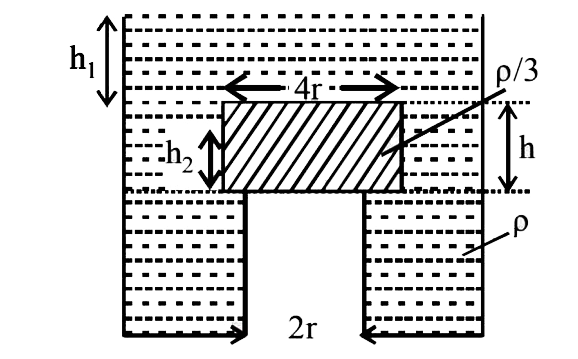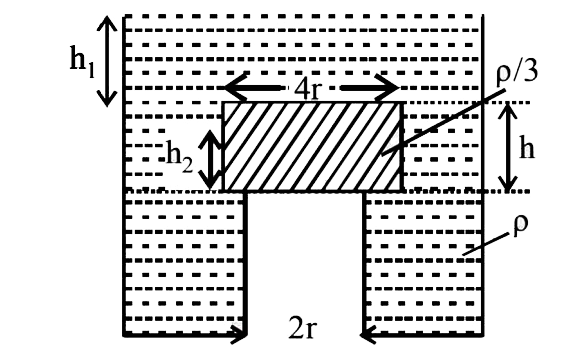A long cylindrical vessel has a small hole of diameter D at its bottom. This vessel can be lowered vertically in water to a depth h without any water entering the vessel. Given : A=surface tension, B=density of liquid, C=acceleration due to gravity. The value of h is
ADBC
2ADBC
3ADBC
4ADBC
The correct Answer is:D
To solve the problem, we need to analyze the forces acting on the water at the hole of the cylindrical vessel when it is submerged in water to a depth h.
1. Understand the Scenario:
- A long cylindrical vessel has a small hole at its bottom.
- The vessel can be submerged to a depth h without water entering it.
- We need to find the value of h in terms of surface tension A, density of the liquid B, acceleration due to gravity C, and the diameter of the hole D.
2. Identify the Forces:
- When the vessel is submerged, the hydrostatic pressure PH at the hole due to the water column above it is given by:
PH=ρgh
where ρ is the density of the liquid (given as B), g is the acceleration due to gravity (given as C), and h is the depth of the water above the hole.
3. Surface Tension Effect:
- The surface tension T acts at the hole and creates a force that opposes the hydrostatic pressure. The force due to surface tension can be expressed as:
FT=T⋅circumference of the hole
- The circumference of the hole (with diameter D) is:
Circumference=πD
- Therefore, the force due to surface tension is:
FT=T⋅πD
4. Setting Up the Equation:
- For the water to not enter the vessel, the hydrostatic pressure must equal the force due to surface tension:
PH⋅A=T⋅Circumference
- Here, A is the area of the hole, which can be expressed as:
A=π(D2)2=πD24
- Substituting this into the equation gives:
ρgh⋅πD24=T⋅πD
5. Simplifying the Equation:
- Cancel π from both sides:
ρgh⋅D24=T⋅D
- Rearranging gives:
h=4TρgD
6. Substituting Given Variables:
- Substitute T with A, ρ with B, and g with C:
h=4ABCD
Final Result:
The value of h is:
h=4ABCD
- A long cylindrical vessel has a small hole at its bottom.
- The vessel can be submerged to a depth h without water entering it.
- We need to find the value of h in terms of surface tension A, density of the liquid B, acceleration due to gravity C, and the diameter of the hole D.
- When the vessel is submerged, the hydrostatic pressure PH at the hole due to the water column above it is given by:
PH=ρgh
where ρ is the density of the liquid (given as B), g is the acceleration due to gravity (given as C), and h is the depth of the water above the hole.
- The surface tension T acts at the hole and creates a force that opposes the hydrostatic pressure. The force due to surface tension can be expressed as:
FT=T⋅circumference of the hole
- The circumference of the hole (with diameter D) is:
Circumference=πD
- Therefore, the force due to surface tension is:
FT=T⋅πD
- For the water to not enter the vessel, the hydrostatic pressure must equal the force due to surface tension:
PH⋅A=T⋅Circumference
- Here, A is the area of the hole, which can be expressed as:
A=π(D2)2=πD24
- Substituting this into the equation gives:
ρgh⋅πD24=T⋅πD
- Cancel π from both sides:
ρgh⋅D24=T⋅D
- Rearranging gives:
h=4TρgD
- Substitute T with A, ρ with B, and g with C:
h=4ABCD
The value of h is:
h=4ABCD
Topper's Solved these Questions
- RACEBOOK - ALLENCHAPTER - RACEEXERCISE - Basic Maths (Thermal Physics) (Temperature scales & thermal expansion)
13 Videos
- RACEBOOK - ALLENCHAPTER - RACEEXERCISE - Basic Maths (Thermal Physics) (Calorimetry)
14 Videos
- RACEBOOK - ALLENCHAPTER - RACEEXERCISE - Basic Maths (Properties of Matter & Fluid Mechanics)(Hydrostatics)
20 Videos
- NEWTONS LAWS OF MOTIONBOOK - ALLENCHAPTER - NEWTONS LAWS OF MOTIONEXERCISE - EXERCISE-III
28 Videos
- SIMPLE HARMONIC MOTIONBOOK - ALLENCHAPTER - SIMPLE HARMONIC MOTIONEXERCISE - Example
1 Videos
Similar Questions
The absolute pressure at a depth h below the surface of a liquid of density ρ is [Given Pa = atmospheric pressure, g = acceleration due to gravity]
View SolutionA cylindrical tank has a hole of diameter 2r in its bottom. The hole is covered wooden cylindrical block of diameter 4r, height h and density ρ/3.

Situation I: Initially, the tank is filled with water of density ρ to a height such that the height of water above the top of the block is h1 (measured from the top of the block).
Situation II: The water is removed from the tank to a height h2 (measured from the bottom of the block), as shown in the figure. The height h2 is smaller than h (height of the block) and thus the block is exposed to the atmosphere.
Find the minimum value of height h1 (in situation 1), for which the block just starts to move up?
View Solution
Knowledge Check
A cylindrical vessel of height 500mm has an orifice (small hole) at its bottom. The orifice is initially closed and water is filled in it up to height H. Now the top is completely sealed with a cap and the orifice at the bottom is opened. Some water comes out from the orifice and the water level in the vessel becomes steady with height of water column being 200mm. Find the fall in height(in mm) of water level due to opening of the orifice.
[Take atmospheric pressure =1.0×105N/m2, density of water=1000kg//m^3andg=10m//s^2. Neglect any effect of surface tension.]A6B4C2D8
A cylindrical tank has a hole of diameter 2r in its bottom. The hole is covered wooden cylindrical block of diameter 4r, height h and density ρ/3.

Situation I: Initially, the tank is filled with water of density ρ to a height such that the height of water above the top of the block is h1 (measured from the top of the block).
Situation II: The water is removed from the tank to a height h2 (measured from the bottom of the block), as shown in the figure. The height h2 is smaller than h (height of the block) and thus the block is exposed to the atmosphere.
Find the minimum value of height h1 (in situation 1), for which the block just starts to move up?
View SolutionA cylindrical tank has a hole of diameter 2r in its bottom. The hole is covered wooden cylindrical block of diameter 4r, height h and density ρ/3.

Situation I: Initially, the tank is filled with water of density ρ to a height such that the height of water above the top of the block is h1 (measured from the top of the block).
Situation II: The water is removed from the tank to a height h2 (measured from the bottom of the block), as shown in the figure. The height h2 is smaller than h (height of the block) and thus the block is exposed to the atmosphere.
In situation 2, if h2 is further decreased, then
View SolutionThe bottom of a cylindrical vessel has a circlular hole of radius r and at depth h below the water] level. If the diameter of the vessel is D, the find then speed with which the water level in the] vessel drops.
View SolutionWater is drained from a vertical cylindrical tank by opening a valve at the base of the tank. It is known that the rate at which the water level drops is proportional to the square root of water depth y, where the constant of proportionality k>0 depends on the acceleration due to gravity and the geometry of the hole. If t is measured in minutes and k=115, then the time to drain the tank if the water is 4 m deep to start with is (a) 30 min (b) 45 min (c) 60 min (d) 80 min
View SolutionWater level is maintained ina cylindrical vessel up to a fixed height H. The vessel is kept on a horizontal plane. At what height above the bottom should a hole be made in the vessel so that the water stream coming out of the hole strikes the horizontal plane at the greatest distance from the vessel.

View SolutionA vessel whose , bottom has round holes with diameter 0.1mm, is filled with water. The maximum height up to which water can be filled without leakage is
View SolutionA wide vessel with a small hole in the bottom is filled with water and kerosene. Find the velocity of water flow if the thickness of water layer is h1=30cm and that of kerosene is h2=20cm brgt

View Solution
